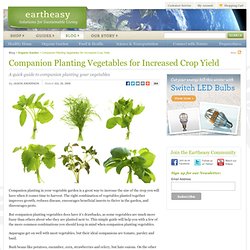

BonsaiSite.com - Bonsai as an art and horticultural practice. Garden, Porch, and Yard. How to Grow 100 Pounds of Potatoes in 4 Square Feet. On many occasions, we've been tempted to grow our own potatoes.

They're fairly low maintenance, can be grown in a pot or in the ground, last a fairly long time if stored properly, and can be very nutritious (high in potassium and vitamin C). Here's more incentive: according to this article, you can grow 100 pounds of potatoes in 4 sq. feet. Learn how after the jump... How To Grow Avocados - Australian Avocados. Blog » Companion Planting Vegetables for Increased Crop Yield. Companion planting in your vegetable garden is a great way to increase the size of the crop you will have when it comes time to harvest.

The right combination of vegetables planted together improves growth, reduces disease, encourages beneficial insects to thrive in the garden, and discourages pests. Blog » Top 6 most cost-effective vegetables to grow. There are many benefits to growing your own vegetables, but saving money is not necessarily one of them.

Some vegetables are simply cheaper to buy at the grocery store, and no amount of gardening savvy will result in a cost-saving benefit. Over the years we have experimented with many vegetable crops, and while saving money is not the prime reason we grow vegetables, it is a consideration in our choice of what to plant. Although we are fortunate to have plenty of ground space for gardening, the work required to keep the beds fertile and weed free discourages us from planting some crops which are ‘dirt cheap’ when bought in season. If you are growing vegetables in the hope of saving money, or want to make the most from limited garden space, here are some suggestions for crops which have delivered real cost savings for us. Small Footprint, Big Yield: Create an Easy Micro Organic Urban Garden Today!
April 28, 2009 by Robin Plaskoff Horton There are two things urban gardeners are short on: space and time.

The Urban Garden, brainchild of Bill Arquitt, resolves both of these issues, making it efficient and simple to plant a vegetable garden with up to 55 plants in a 3-foot deep by 4-foot wide footprint. The contained six level tiered system is nearly maintenance-free, eliminating heavy weeding, and its northwestern cedar construction renders it naturally bug repellent. Vegetable Spacing Guide".
Kenneth Parker Photography. 6 Months In the Greenhouse. My little greenhouse is cram packed in April.

I built my 50 dollar greenhouse about 6 months ago and I thought some of you might be interested in what I’ve done with it and how it’s performed so far. Tips for Gardening - Garden Vegetable Tips - How to Vegetable Garden. Organic Lawn Care For the Cheap and Lazy. Lawn care in a nutshell: Must do: Set your mower as high as it will go (3 to 4 inches).

Water only when your grass shows signs of drought stress and then water deeply (put a cup in your sprinkler zone and make sure it gets at least an inch of water). Optional: Fertilize with an organic fertilizer in the fall and spring. I recommend the Ringer brand. Have the pH of your soil professionally tested. Now for the verbose details on lawn care: A little knowledge makes it so damn near anything can qualify for the "cheap and lazy" label.
The key to the lawn care game is competition. Inverted Indoor Planter for Hanging Plants Upside-Down. Small veggie plots, big rewards. Living lightly from the ground up. Flash in the Pan. I haven't purchased garlic since 1996.

That's because I grow enough to eat a bulb of garlic every day, year-round. While most of my garden adventures are hobby-level attempts at self-sufficiency, my garlic crop is for real. Garlic is an overwintering crop, planted in fall and harvested mid-summer. So if you want to have a crop next year, it's time to think about planting. A year's supply of garlic hanging in your garage hints at many great meals to come, but by the time you reach that milestone the rewards have already been flowing for months. As spring continues, your plants will continue to skyrocket, and in late May—assuming you planted a flowering variety—you'll be treated to a funky display of garlic blossoms curling from the plant tops. The flowering varieties of garlic are collectively called hardnecks, so named because of their woody flowering stalks.
The DIY Modern Outdoor Succulent Planter #2. Home improvement projects. VERTICAL VEGETABLES: "Grow up" in a small garden and confound the cats! Sitemap. Louisville tools classifieds - craigslist. Gardening for the People. Nice Home Garden Patio & Wood Path Design Idea. Growing Tomatoes, Tomato Growing Tips. Prevent Diseases From Starting Growing healthy tomatoes is really fairly easy, but you will want to keep a few things in mind.

Solarize your soil Solarize your soil to control nematodes and weeds. It's also an effective treatment for other pests and disease pathogens. Moisten the area and cover it with a sturdy plastic tarp. Spray a Kelp Solution Spraying your plants with a kelp solution two or three times a season boosts vigor. Plant marigolds Spider mites love marigolds, and so do rabbits, so planting marigolds might attract pests into your garden which isn't so great. On the other hand, however, marigolds can be used to help soil with nematode problems, as long as it's done properly. Before you try this, determine if this is a method you want to try considering there are some pros and cons. Rotate Your Crops To avoid soil-borne diseases, place your tomatoes on a three year rotation schedule, and rotate with unrelated crops such as corn, beans or lettuce, or grow a cover crop.